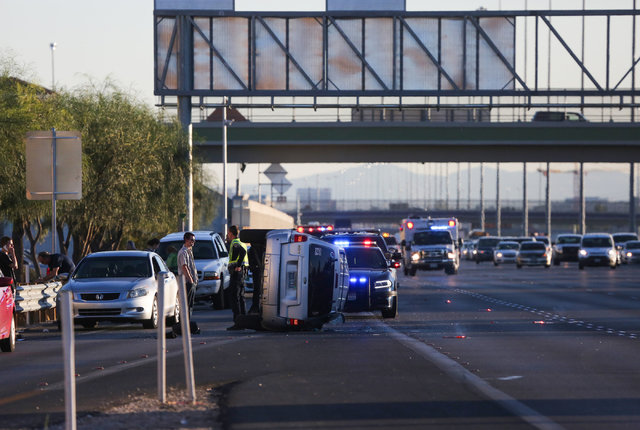Las Vegas car insurance rate hikes likely to continue
Las Vegas drivers have long known the sting of costly car insurance.
But 2016 has seen even those with impeccable driving records face rate increases seemingly out of nowhere hitting them like a Mack truck.
“I get calls from my clients all the time, ‘Why are my rates going up? Why are my rates going up?’” said Mark Citsay, a 21-year insurance agent with State Farm in Las Vegas.
Conventional wisdom has long attributed the high price of coverage in Clark County to an abundance of car thieves, drunken drivers, and aggressive personal injury lawyers. And while these notions may offer a starting point, they don’t necessarily account for recent rate hikes experienced by most Nevada drivers.
“Generally speaking we are seeing a trend where the rates are increasing,” said Rajat Jain, property and casualty chief insurance examiner for the Nevada Division of Insurance. “About five, six, seven years ago, rates were essentially going downward or were flat because less claims were being filed. But lately the trend has reversed, and begun moving upward.”
Nevada currently ranks 15th among states with the highest insurance rates, according to research from the National Association of Insurance Commissioners, with an average rate of $1,351 annually — $127 higher than the national average, and up from $1,078 annually in 2014, when Nevada ranked 6th.
So as rates are going up noticeably across Nevada, the state’s ranking among the costliest is dropping, suggesting that despite the hefty increases the state is being spared from the most painful insurance hits.
“The recent rate changes are all over the place,” Jain said, explaining how complex formulas used to assess multiple risk factors produce rates that differ by ZIP code — with premiums in Las Vegas sometimes costing twice what drivers pay in more rural parts of the state.
According to the Division of Insurance’s 2015 Insurance Market Report, a document submitted biennially to state legislators, rate increases typically ranged between 2 percent and 5 percent, but in some cases increases of only a fractional percentage point or more than 10 percent.
The Division of Insurance regulates more than 180 providers of auto coverage in Nevada. Their job is to protect consumers by making sure insurers can guarantee solvency, and thus Jain and his team of actuaries must approve requests for rate increases or decreases.
In this capacity, they also monitor the percentages of insurance premiums that go to paying out claims. And that number has been on the rise — challenging insurance company operations.
In 2011, Nevada insurers paid out just over $1 billion — about 62 percent of all premiums taken in. By 2013 the direct loss rose to $1.13 billion, resulting in a 66 percent payout. For 2015, insurer losses grew to $1.4 billion, for a direct loss ratio of nearly 73 percent.
“We have to raise rates to make sure insurers can meet their obligations to policyholders when claims occur,” Citsay said.
And in Nevada, claims have been occurring more frequently.
From 2014 to 2016, Nevada experienced the highest increase in collisions of all states — 9.7 percent, according to data from the Federal Highway Administration presented at a recent conference of the Property Casualty Insurers Association of America.
Las Vegas police reported more than 13,000 collisions in the first three quarters of 2016, up rather dramatically from fewer than 8,500 at the same point in 2015.
Adding to costs stemming from increased accident frequency are costs of increased accident severity — a term referring to a claim’s total cost to the insurer.
“All that technology that supposedly prevents accidents — the sensors, the GPS, the Wi-Fi, all those things that are built into cars now — if you get in an accident, they’re very expensive to replace,” Citsay said. “There’s no little fender bender anymore where you just take it to the body shop and they take a hammer and bang it out for you. Every incident ends up in the thousands of dollars.”
With injuries and medical bills, costs can run even higher.
“Nationwide we are seeing an increase in medical costs, and that also can play a role in driving the rates higher as it impacts a company’s ability to remain solvent,” Jain said.
One area of influence where Las Vegas has previously stood out but now just may be part of a national trend is with auto theft — occurrences of which ticked up 3.1 percent nationally in 2015, after seeing declines for 23 of the previous 24 years, according to the FBI Uniform Crime Reports.
In 2006 and 2007, Las Vegas led the country for claims of auto theft. But thanks in part to a task force assembled by then-Gov. Jim Gibbons to address the issue, Jain said, Las Vegas dropped out of the top 10 cities ranking for car theft by 2010 and has not returned.
Nevada saw car thefts begin to creep up again in 2014 by 1.6 percent, and then rise by 11.9 percent in 2015, according to statistics from the Nevada Department of Motor Vehicles.
Also in 2015, Las Vegas was No. 1 in the country for motorcycle thefts.
“It’s not simple, but when it comes down to rating an insurance exposure to risk it all comes down to claim activity,” Jain said. “How frequently are companies seeing claims, and how much are they paying for each claim?”
And because data takes time to mature, he said, influencing factors that began in 2014 and 2015 drove rates up in 2016, and that’s the same reason why statistics suggest a general trend of increasing costs for car insurance will likely continue into 2017.

















